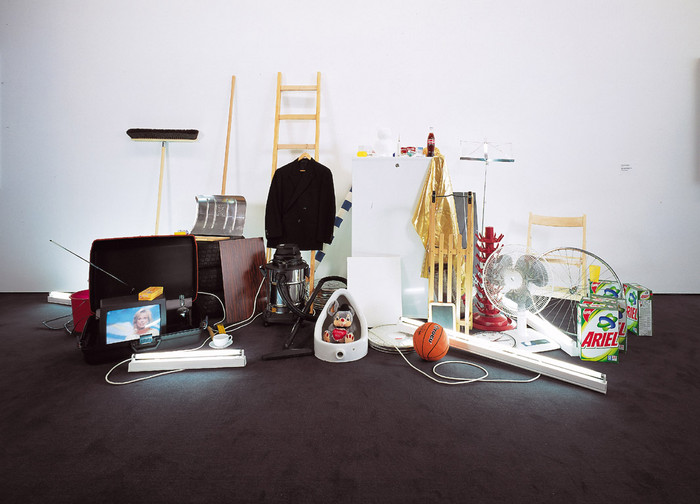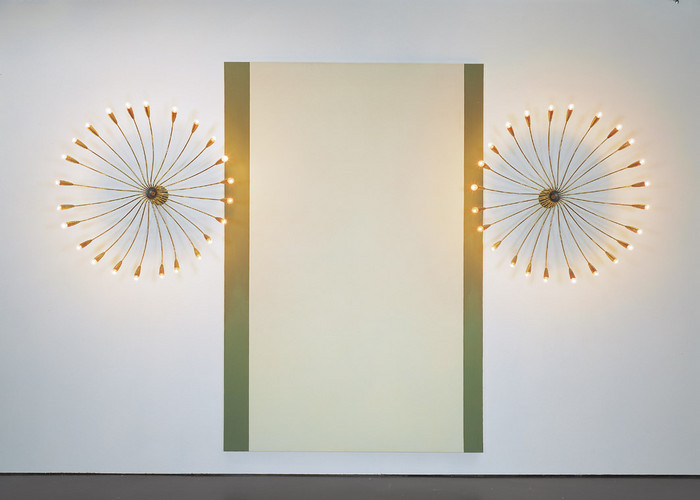John M Armleder

John M Armleder
Don't do it! (Readymades of the 20th Century) F.S. (Furnitures Sculptures), 1997/2000
Various materials
180 x 400 x 1,5 cm
Acquired/Erworben 2001
In his paintings, objects, installations, sculptures, etc., John M. Armleder looks into the styles, dogmas and -isms of 20th Century art by paraphrasing, destroying and redefining them all at the same time. Don't do it! combines the most famous ready-mades, from Duchamp’s Urinoir (1917) via Warhol's soap powder boxes and Beuys' felt rolls (around 1960) through to Tiravanija's teabag (1998) – but all of them as new, fresh-from-the-market acquisitions. Don’t do it! is a double farewell to the concept of the original in art: in the course of time, the ready-made, which was to destroy the aura of the artistic original and the associated ideals and utopias, has risen to the status of an icon itself. Armleder's sculpture tears down the ready-made from its pedestal for a second time to move the essential and the truly ›original‹ artistic approach into the focus.
Das Werk von John M. Armleder setzt sich in Bildern, Objekten, Installationen, Skulpturen etc. mit den Stilen, Dogmen und Ismen der Kunst des 20. Jahrhunderts auseinander, indem es diese zugleich paraphrasiert, zerstört und neu definiert. So versammelt Don't do it! die berühmtesten Readymades, von Duchamps Urinoir (1917) über Warhols Waschmittelboxen und Beuys Filzrollen (um 1960) bis zum Teebeutel Tiravanijas (1998) – doch alle als marktfrische Konsumwaren. Don’t do it! ist eine doppelte Verabschiedung des Originalbegriffs in der Kunst: das Readymade, das die Aura des künstlerischen Originals und die damit verbundenen Ideale und Utopien zerstören sollte, ist im Laufe der Zeit selbst zur ›Ikone‹ aufgestiegen. Armleders Skulptur holt es noch ein zweites Mal vom Sockel, um das Essentielle und wahrhaft ‚originelle' künstlerischen Denkens in den Blick zu rücken.
Don't do it! (Readymades of the 20th Century) F.S. (Furnitures Sculptures), 1997/2000
Various materials
180 x 400 x 1,5 cm
Acquired/Erworben 2001
In his paintings, objects, installations, sculptures, etc., John M. Armleder looks into the styles, dogmas and -isms of 20th Century art by paraphrasing, destroying and redefining them all at the same time. Don't do it! combines the most famous ready-mades, from Duchamp’s Urinoir (1917) via Warhol's soap powder boxes and Beuys' felt rolls (around 1960) through to Tiravanija's teabag (1998) – but all of them as new, fresh-from-the-market acquisitions. Don’t do it! is a double farewell to the concept of the original in art: in the course of time, the ready-made, which was to destroy the aura of the artistic original and the associated ideals and utopias, has risen to the status of an icon itself. Armleder's sculpture tears down the ready-made from its pedestal for a second time to move the essential and the truly ›original‹ artistic approach into the focus.
Das Werk von John M. Armleder setzt sich in Bildern, Objekten, Installationen, Skulpturen etc. mit den Stilen, Dogmen und Ismen der Kunst des 20. Jahrhunderts auseinander, indem es diese zugleich paraphrasiert, zerstört und neu definiert. So versammelt Don't do it! die berühmtesten Readymades, von Duchamps Urinoir (1917) über Warhols Waschmittelboxen und Beuys Filzrollen (um 1960) bis zum Teebeutel Tiravanijas (1998) – doch alle als marktfrische Konsumwaren. Don’t do it! ist eine doppelte Verabschiedung des Originalbegriffs in der Kunst: das Readymade, das die Aura des künstlerischen Originals und die damit verbundenen Ideale und Utopien zerstören sollte, ist im Laufe der Zeit selbst zur ›Ikone‹ aufgestiegen. Armleders Skulptur holt es noch ein zweites Mal vom Sockel, um das Essentielle und wahrhaft ‚originelle' künstlerischen Denkens in den Blick zu rücken.

John M Armleder
Avec les deux lustres (FS), 1987-1993
Acrylic on canvas, 2 lamps
300 x 200 cm
Acquired/Erworben 2003
John M. Armleder’s Avec les deux lustres (FS) created in 1993 ranks among the furniture sculptures. The two 24-armed chandeliers made of brass, mounted on either side of a canvas, are slightly rusty and clearly reveal the traces of use. This picture object sums up the borders crossed by 20th century art and design, from De Stijl and Bauhaus via Minimal to the visual overkill of contemporary hysteria about design and presentation. The image paraphrases the classical American Color Field Painting of artists like Barnett Newman, for example, in its form and color scheme. To the extent that the ensemble plays with the religious triptych type and the chandeliers’ frontality triggers associations with rose windows and haloes, the two chandeliers are also commenting ironically on the transcendental claim of Newman’s art by both presenting it demonstratively and exploiting it to gain their own enigmatic charge. Duchamp and Malewitsch, anti-art and idealistic aesthetics – the two great opposites of 20th century art – have come together in John M. Armleder’s work as a smoothly functioning entity.
John M Armleders 1993 entstandene Arbeit Avec les deux lustres (FS) zählt zur Werkgruppe der Möbelskulpturen. Die beiden 24-armigen Deckenlampen aus Messing, beidseitig neben einer Leinwand angebracht, sind leicht angerostet und weisen deutliche Gebrauchsspuren auf. Das Bildobjekt summiert die Grenzgänge von Kunst und Design des 20. Jhd., von De Stijl und Bauhaus über Minimal bis zum virtuellen Overkill zeitgenössischer Ausstattungshysterie. Das Bild paraphrasiert in Format und Farbigkeit die amerikanische Farbfeldmalerei, etwa eines Barnett Newman. Das Ensemble spielt mit dem sakralen Typus des Triptychons, die Lampen wecken in der Frontalität Assoziationen an Rosette und Heiligenschein. So kommentieren die beiden Deckenlampen ironisch den transzendentalen Anspruch der Kunst Newmans, indem sie ihn zugleich demonstrativ vorführen und für ihre eigene enigmatische Aufladung benutzen. Duchamp und Malewitsch, Antikunst und idealistische Ästhetik – die beiden großen Antipoden der Kunst des 20. Jhd. haben im Werk Armleders zu reibungslos funktionierender Einheit gefunden.
Avec les deux lustres (FS), 1987-1993
Acrylic on canvas, 2 lamps
300 x 200 cm
Acquired/Erworben 2003
John M. Armleder’s Avec les deux lustres (FS) created in 1993 ranks among the furniture sculptures. The two 24-armed chandeliers made of brass, mounted on either side of a canvas, are slightly rusty and clearly reveal the traces of use. This picture object sums up the borders crossed by 20th century art and design, from De Stijl and Bauhaus via Minimal to the visual overkill of contemporary hysteria about design and presentation. The image paraphrases the classical American Color Field Painting of artists like Barnett Newman, for example, in its form and color scheme. To the extent that the ensemble plays with the religious triptych type and the chandeliers’ frontality triggers associations with rose windows and haloes, the two chandeliers are also commenting ironically on the transcendental claim of Newman’s art by both presenting it demonstratively and exploiting it to gain their own enigmatic charge. Duchamp and Malewitsch, anti-art and idealistic aesthetics – the two great opposites of 20th century art – have come together in John M. Armleder’s work as a smoothly functioning entity.
John M Armleders 1993 entstandene Arbeit Avec les deux lustres (FS) zählt zur Werkgruppe der Möbelskulpturen. Die beiden 24-armigen Deckenlampen aus Messing, beidseitig neben einer Leinwand angebracht, sind leicht angerostet und weisen deutliche Gebrauchsspuren auf. Das Bildobjekt summiert die Grenzgänge von Kunst und Design des 20. Jhd., von De Stijl und Bauhaus über Minimal bis zum virtuellen Overkill zeitgenössischer Ausstattungshysterie. Das Bild paraphrasiert in Format und Farbigkeit die amerikanische Farbfeldmalerei, etwa eines Barnett Newman. Das Ensemble spielt mit dem sakralen Typus des Triptychons, die Lampen wecken in der Frontalität Assoziationen an Rosette und Heiligenschein. So kommentieren die beiden Deckenlampen ironisch den transzendentalen Anspruch der Kunst Newmans, indem sie ihn zugleich demonstrativ vorführen und für ihre eigene enigmatische Aufladung benutzen. Duchamp und Malewitsch, Antikunst und idealistische Ästhetik – die beiden großen Antipoden der Kunst des 20. Jhd. haben im Werk Armleders zu reibungslos funktionierender Einheit gefunden.
Tag: John M Armleder
